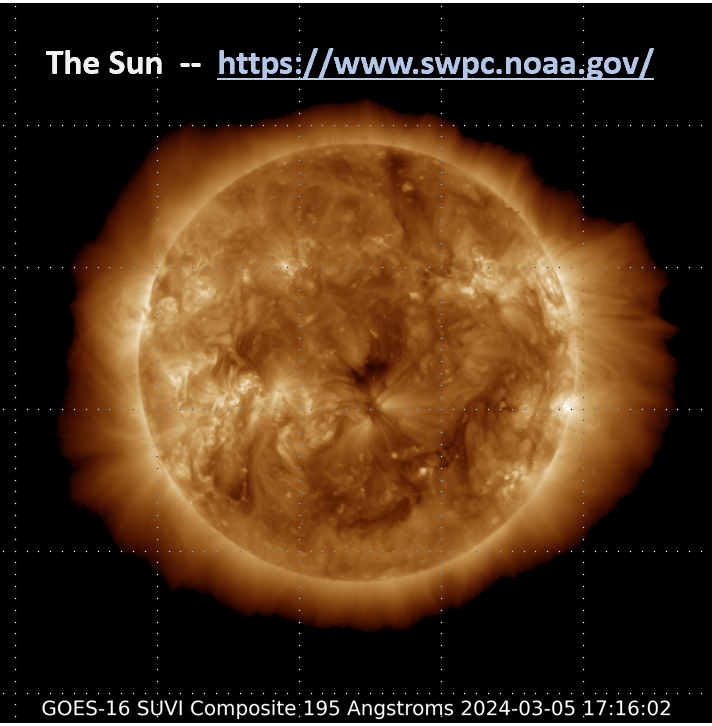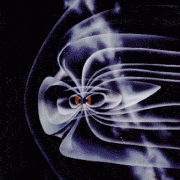Oh No! Not Another Bleeping Disaster!
By Bob Buddemeier
[I have drawn on others for facts; errors and opinions are mine alone – RWB]
I have always been fascinated by the power of Nature, especially when manifested violently and/or extensively. Any kind of storm, volcanoes, earthquakes, wildfires – all are engrossing, as are the impacts as well as people’s preparations and responses. History indicates that we (technologically advanced modern humans) are much better prepared to deal with natural disasters than our forebears were. We now have forecasters and fire engines, helicopters, emergency agencies and supplies, near-real-time earth observing satellites, long distance communications, etc., etc. A couple of millennia ago, there wasn’t much people could do except sacrifice a virgin and hope for the best.
Given the apparent invincibility of technology, it was exciting to come across a natural event that offered no significant danger to primitive people, but posed an existential threat to Homo technicalis. On February 26, The New Yorker posted online What a Major Solar Storm Could Do to Our Planet, by Kathryn Schultz. (https://www.newyorker.com/magazine/2024/03/04/what-a-major-solar-storm-could-do-to-our-planet). In the best New Yorker tradition, it is 8,334 words long. I will summarize the key points more succinctly, and then take the discussion somewhat further than the article does. Quotations, unless otherwise attributed, are from the article.
Like Earth, the Sun has a fluid surface layer, but the Earth’s consists of air and water, whereas the Sun’s is plasma – a nuclear-fueled ultra-high-energy soup of ions and electrons. Like Earth’s fluid surface, the Sun’s surface is subject to storms, but although we have developed a pretty fair understanding of the how and why of Earth storms, we haven’t gotten much past observing the symptoms (like sunspots and solar flares) in figuring out solar storms.
 Sunspots – an indicator of solar activity and storms — can occur anywhere on the Sun’s surface, with a frequency varying over an 11-year cycle (a maximum is due within the next year). Large sunspots indicate major storms. (https://www.swpc.noaa.gov/)
Sunspots – an indicator of solar activity and storms — can occur anywhere on the Sun’s surface, with a frequency varying over an 11-year cycle (a maximum is due within the next year). Large sunspots indicate major storms. (https://www.swpc.noaa.gov/)
What is a Solar Storm? When the magnetic lines of force on the rotating sun get tangled up, a storm occurs with one or both of two results: a solar flare, where the storm emits a pulse of high energy photons (gamma rays, X-rays, light); or a coronal mass ejection, which ejects a huge cloud of solar plasma. A large flare and a large ejection occurring together constitute a major storm. The effects we will be talking about occur when a major sunstorm ejects photons and plasma directly toward Earth.
What are the effects of a Solar Storm? – General and space-based: On Earth, the major effects stem from the interaction of the Earth’s magnetic field with electromagnetic effects of a strong flux of photons and of charged particles. The biggest effect that is directly detectable by humans is the occurrence of strong auroras at much lower latitudes than usual (as far south as central Mexico, and with daylight intensity in midcontinent North America). That would have been the only effect experienced by pre-technical populations, although it undoubtedly had a major psychological impact (oops, there goes another virgin).
The effects of electromagnetic disruption on the electrical and electronic systems upon which modern civilization depends would be at least temporarily disabling. For that reason, the major military powers have developed EMP (Electro-Magnetic Pulse) weapons that produce results similar to a solar flare, but with greater intensity over a smaller area (see https://doh.wa.gov/sites/default/files/legacy/Documents/Pubs/320-090_elecpuls_fs.pdf).
The Earth’s magnetic field shields us from most of the hazards of solar and cosmic radiation by deflecting charged particles to the poles. For objects (e.g., satellites) or people (e.g., astronauts or extraterrestrial colonists) outside of the Earth’s magnetic field, radiation can pose a destructive or lethal threat. Neither the moon nor Mars has a magnetic field, so radiation is one of the greatest barriers to extended space exploration. Closer to home, the damage to the massive inventory of communication, positioning and remote sensing satellites will disrupt far more capabilities than most of us can imagine. For these, as well as Earth-based facilities, shutting down the equipment can reduce (but not eliminate) vulnerability– if there is enough warning to safely do so.
What are the effects of a Solar Storm? – Earthbound specifics: The effects of a major sunstorm will be the shutdown, and possible destruction, of facilities and equipment that provide or depend on electricity. Long conductors, such as extensive power and communication grids, are especially vulnerable. We know that the effects of a geomagnetic storm will be affected by geology, geography, and the design, siting, and operation of equipment, so there will be a patchwork of effects, with some things destroyed, others damaged, and some just turned off — including local, freestanding facilities as well as large systems. In 2008 the National Academy of Sciences reported “…that much of the country’s critical infrastructure seemed unlikely to withstand [a maximum solar storm]. Extensive damage to satellites would compromise everything from communications to national security, while extensive damage to the power grid would compromise everything: health care, transportation, agriculture, emergency response, water and sanitation, the financial industry, the continuity of government. The report estimated that recovery from a [G5+] storm could take up to a decade and cost many trillions of dollars.” Preparedness has improved since then, but many of the vulnerabilities – and uncertainties – still remain.
What can be done, and are we doing it? – National and Global: There are solar observatories that keep a constant watch on the sun (see the New Yorker article, and https://www.swpc.noaa.gov/phenomena/coronal-mass-ejections), with people standing by to relay a warning if dangerous symptoms appear. However, the leading edge of a solar flare can reach the Earth in less than ten minutes, and cause the loss of many radio communication frequencies due to ionization of the upper atmosphere. Less than a day later, and potentially lasting for at least two days, the cloud of energetic particles from the coronal mass ejection arrives. That scrambles the Earth’s magnetic field, and initiates the geomagnetic storm that has the potential for causing the critical shutdowns.
Some critical facilities and functions (the military, Homeland Security, and communication- or power- intensive organizations) have plans in place, although they are not usually publicized because of national security issues. In terms of issues most relevant to the general population, there is…” a federal directive that, as of this January, requires every provider of bulk power to have a plan in place to deal with a “benchmark geomagnetic disturbance event.” That directive is important, but the benchmark itself is troubling. It was established by using thirty years of magnetic-field data to extrapolate the likely magnitude of a once-in-a-century storm. The resulting standard is clear, uniform, achievable, extremely useful during most solar storms, and wholly inadequate for severe ones.”
The reconstructed record of major storms identifies 1859, 1872, and 1921 as (pretechnology) years of severe events, with numerous other smaller ones that were still able to do perceptible damage. None of those three largest historical storms identified are included in the past thirty years, or occurred under present conditions of technical development.
What can be done, and are we doing it? – Local and Personal: In spite of emphasis on emergency preparedness, a majority of individuals, small businesses and local agencies are not well prepared for the more familiar disasters, and many may not even be aware that solar storms are an issue. The precautions recommended for natural disasters are qualitatively appropriate for a solar storm response – preparation to be without utilities, food and water, communications and transportation. However, when scale is considered, the preparations useful for Earth-based disasters are quantitatively inadequate for a major solar storm.
A G5 solar storm (the biggest imaginable, like an F5 tornado or a Category 5 hurricane) will affect the entire planet. By contrast, the area that would be affected by the Cascadia earthquake is about 240,000 square miles – a miniscule fraction of the area affected by the solar storm. In spite of the scale difference, estimated probabilities are very similar: for the G5 solar storm: a 12% chance in the next decade, and for the Cascadia Great Earthquake, a 37% chance in 50 years. These differences and similarities dramatically change considerations of what to do and how to do it.
What to think (or worry) about: We are considering an off-the-charts G5 storm, which no living adult has ever experienced. However, we can’t really predict many details. Nor can we count on local or regional assistance, even if relatively prepared.
” …because solar storms affect an unusually wide geographic area and an unusually broad range of technologies, they are more likely than other disasters to cause cascading failures… They can affect large areas of the world, which minimizes access to outside help in the aftermath. If an earthquake devastates Los Angeles, aid can pour in from neighboring regions. But, if a solar storm devastates New York, anywhere close enough to help will likely be devastated, too… [And,] because space weather affects so many technologies, a severe storm could expose dependencies among them that we did not fully appreciate, or did not recognize at all. Our vast and interrelated technological infrastructure could turn out to harbor a single point of failure—a component, no matter how central or trivial, whose malfunction shuts the whole thing down.”
The size of the affected area determines the rate at which assistance arrives or recovery can occur. Depending on location and season, prolonged isolation could result in breakdown of services, loss of governmental control, anarchy, and famine. In addition to crime, movement of refugees from one area to another could be another disaster-compounding factor. Internationally, the recent pandemic demonstrated some of the risks inherent in globalization; damaging or devastating much of the planet would take that several large steps further. World order, as well as local, would be threatened if larger or better armed states or groups invade their neighbors in search of scarce resources, or as pre-emptive self-protection.
What to do: (1) Think and plan for the solar storm contingency; since the fuel pumps and charging stations won’t work it’s probably best to shelter in place, or at least close by. (2) Reconsider your level of preparation – if you now have three days of supplies for that multi-week emergency, you might want to up the inventory a little for the multi-month event. (3) Form or join a compatible mutual support and assistance group. Safety in numbers can take many forms. (4) A solar generator that is not connected to a power grid stands a good chance of surviving a solar storm. Although it would require significant space and money, its benefits beyond just sunstorm preparation might justify consideration (see https://thecomplement.info/2023/08/28/the-limits-to-emergency-solar-power/).
And if all else fails, check around for some expendable virgins.



Leave a Reply
Want to join the discussion?Feel free to contribute!